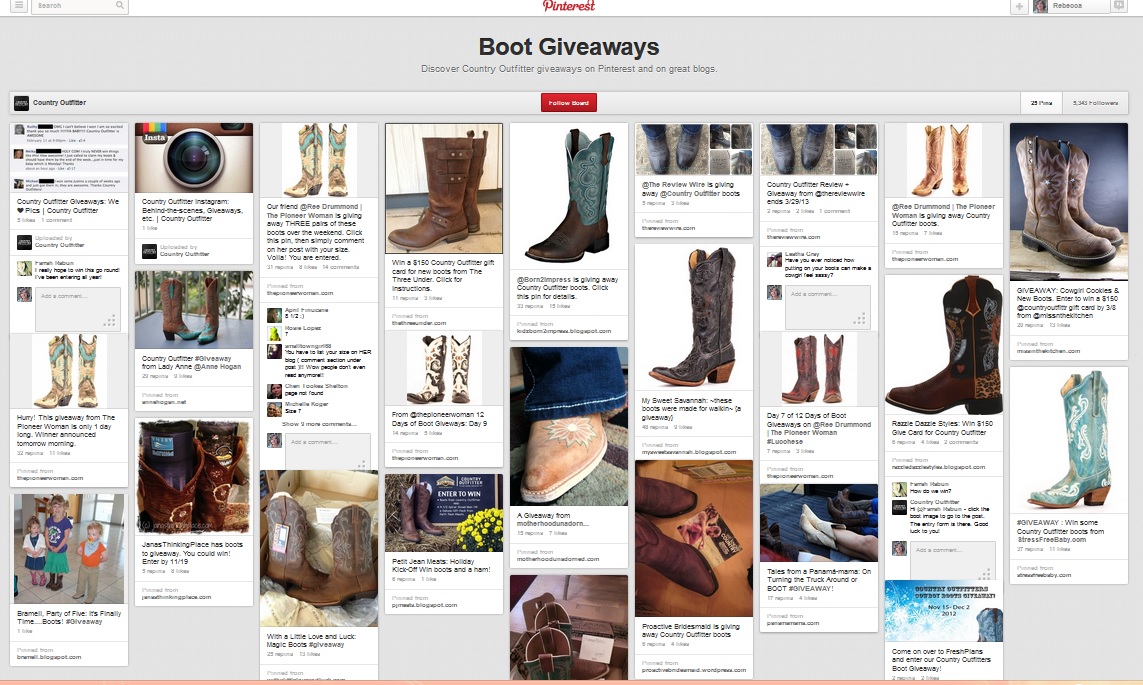Your cart is currently empty!

Forget One Size Fits All Social Media
If you do social media for your business, you will have seen — and perhaps been tempted by — those automated social media plans. People like me keep telling you they won’t work, but you may still be tempted. Let me share with you three examples of social media campaigns I’ve interacted with recently. I think you’ll see why one size doesn’t fit all.
First, let’s look at Country Outfitters, a boots and jeans place which is sponsoring the Arkansas Women Bloggers meetup later this month. As a part of that sponsorship, they’re giving boots to bloggers– a pair to wear and a pair to give away.
Country Outfitters is requiring participants to do some pinning and posting of their favorite pair of boots. They know their population. These ladies are pinning and posting and liking and sharing with a degree of wanton friendliness that we rarely see in our field. Sure, Country Outfitters gets dozens of their pictures posted, with links right back to their catalog, but the pinners are making friends with each other and having fun. Country Outfitters has provided a fun social event that will cause the bloggers and the readers of each of those bloggers to like the company — not just to “Like” them on Facebook, but to think of them as a fun, generous, friendly place where they will choose to shop in the future. I don’t know what this campaign is costing them, but I bet it’s worth it.
This is the ideal social media campaign. You see this kind of case study in blog posts and articles, and it is often presented as a step by step set of instructions.
The second example, EthoSource, is an upscale purveyor of used office furniture. I think we can guess that a shout out to business bloggers offering them a free desk chair if they pin their favorite on a special group board would not lead to facilities managers emailing each other, “Squee! I love the chair you picked out! I know we’ll be BFFs!”
I could be wrong. I just get that feeling. I’m encouraging EthoSource to use Pinterest, and their office design board is the place you should go to get inspired about your next cubicle purchase, but people don’t get as social over cubicles as they do over shoes. Office supplies, yes, but not furniture.
We talked about Facebook, too, EthoSource and I. I noticed that they were categorized as a local business, and suggested that they play that up. Many communities are very supportive of their local businesses, and Facebook can tap into that as well as individual sociability.
EthoSource pointed out that they live in an Amish community. Not a whole lot of Facebook participation there. EthoSource is probably better off with LinkedIn, YouTube, and Twitter– all places where people look when contemplating serious business purchases.
Knowing your audience makes a big difference in your social media plans.
The third example is Indramat-US, a company that services motion control equipment from Bosch-Rexroth. Yes, in case you were wondering, there is actually a Pin of an Indramat servo motor at Pinterest. However, there’s not much of a social media community around this particular set of services. The company’s competitors are on Twitter, Facebook, and even in a rare case or two on Pinterest, but they have few followers and nobody much is making friends with them.
Does that mean that they should not use social media? A major online publication for electrical engineers brought the question up in this rather endearing way:
The phrase “social media and engineers” makes people screw up their faces in puzzlement as if they’re grappling with the logic of phrases like “military intelligence” or “scrumptious vegan cuisine.”
Their conclusion? It’s coming. It might be slow, but there are already good examples out there, and people who base a strategy on their belief that engineers will never use social media are going to feel a lot like the guys who said there was no practical use for a home computer. There are already people with names like Kyle and Dakota needing Indramat service, and in a few years there’ll be Laurens and Olivias. As EE Times put it, “Live with it, OK?” And, as a popular Pin puts it, “Next year you’re going to wish you had started now.” Online visibility takes time, so the second best time to get to work on your visibility is now (the best time is already past).
What kinds of resources should each of these companies put into social media and how should they approach it? If you came up with an identical answer for each company — well, you’re wrong, that’s all. Their goals are different, their populations are different, their opportunities are different. They’re different.
Their solutions will not be the same.
by
Tags:

Leave a Reply